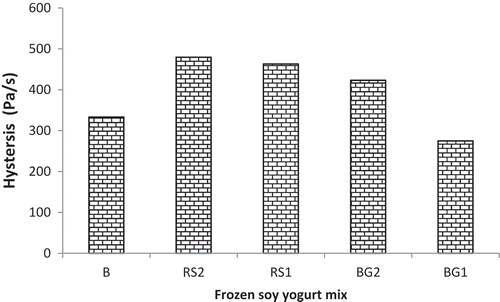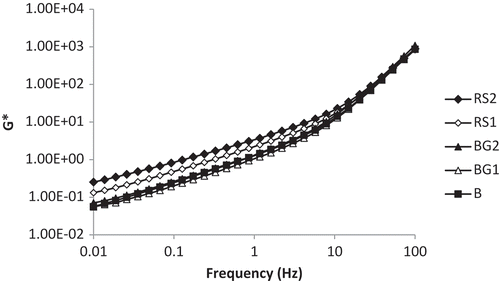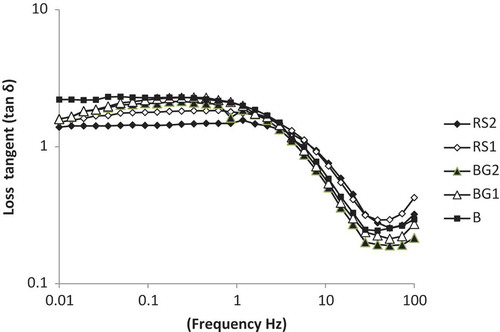ABSTRACT
The present study investigated the effect of resistant starch (0, 1%, 2%) and β-glucan (0, 1%, 2%) on the steady and dynamic rheological properties of frozen soy yogurt mixes. The results showed that addition of fibres to the mix caused an enhancement of pseudoplasticity. The power law model was the best model to fit with data. The lowest and the highest of hysteresis loop area belonged to sample containing 1% β-glucan and 2% resistant starch, respectively. Dynamic rheology results showed that storage modulus (G’) and loss modulus (G”) increased within the frequency range of 0.01–100 Hz. The loss tangent (tan δ) of all samples was above 1, indicating liquid viscoelastic behaviour. Resistant starch at concentration of 2% as compared to β-glucan was a better choice to modify the rheological properties of frozen soy yogurt mixes.
Introduction
Knowledge of the rheological characteristics of food items is important for quality control, processing, and selection of suitable equipment.[Citation1] Study of the viscoelastic properties is a rheological characterization of the food system.[Citation2] Viscoelastic refers to the simultaneous existence of solid and fluid behaviour. These properties are studied by using oscillatory tests to determine the storage and loss modulus and their complex viscosity.[Citation2] One of the most important quality characteristic of ice cream is texture, which is a result of its structure.[Citation3] Ice cream structure is attributed to the macromolecules present in the mix: fat, protein, and carbohydrates.[Citation4] The kind and concentration of ingredients also play an important role in the rheology of ice cream and similar products.[Citation2] Dietary fibres are one of the ingredients that can be added to food for different purposes. They are carbohydrate polymers that cannot be digested or absorbed in the small intestine. Addition of dietary fibres can provide numerous functional properties. Fibres contribute to the modification of rheological and sensory characteristics of food.[Citation5] Bahrami et al.[Citation6] reported that β-glucan and xanthan as fibre have an influence on the water-holding capacity and gel firmness of yogurt. Soukolis et al.[Citation5] stated that oat and wheat fibres improved the rheological properties significantly.
β-glucan is the fibre present in barely and oat. It is an unbranched polysaccharide composed of (1→4) and (1→3) linked β-D-glucopyranosyl units in varying proportions.[Citation7] Besides the nutritional benefits, β-glucan as a hydrocolloid can be used to modify the texture and rheological properties of food. Resistant starch includes the portion of starch that can resist digestion by human amylase in the small intestine and thus reach the colon.[Citation8] It can control the rheological behaviour of the food matrix due to its water-binding capacity and thickening effect. Frozen yogurt is a complex fermented frozen dairy dessert. It combines the physical characteristics of ice cream and the sensory properties of yogurt.[Citation9] Incorporation of soy to this product provides some healthy effects including lowering the risk of cancer, lowering cholesterol, and lowering cardiovascular diseases.[Citation10] The aim of this study was to evaluate the effect of β-glucan and resistant starch as dietary fibres on the rheological properties of the frozen soy yogurt mix.
Materials and methods
Preparation of frozen soy yogurt
Soymilk blend containing 8% soy flour, 4% skim milk powder, and 1% food grade sodium citrate was prepared by dissolving in hot water (90–95°C).[Citation11] β-glucan from oat and resistant starch was added to the mixture at different levels (0, 1, and 2%). The mixture was stirred completed and heated at 85°C for 30 min. After cooling the mixture to 42°C, yogurt starter (0.2%) (YF-L812, CR-Hansen, Denmark) was added and followed by incubation at 42°C. When acidity reached to 80° Dornic, the fermentation process was stopped and the yogurt was cooled to 10°C. To prepare the frozen yogurt mix, sugar (16%), stabilizer–emulsifier mix (0.2%, lux6700, Cargill, France), and skim milk powder (to adjust the total solid to 35%) were dissolved in water and heated at 85°C for 30 min. After cooling to 10°C, the mixture was blended with yogurt and aged at 2°C for overnight.
Rheological analysis
Steady rheology: The rheological behaviour of the aged frozen yogurt mix was determined using a rheometer with concentric cylinder geometry according to Dogan et al.[Citation2] with modifications. The samples were allowed to equilibrate for 5 min prior to measurements. The measurements were carried out within the shear rate range of 0.01–300 1/s at 2°C. Throughout the shearing, a total of 30 data points were recorded at 10 1/s intervals. The shear stress and apparent viscosity were determined as a function of the shear rate. To explain the frozen yogurt mix behaviour, experimental rheological data were fitted to the power law model, and then flow behaviour index (n) and consistency coefficient (k) values were calculated:
where k is the consistency coefficient (pa.sn), γ is the shear rate (s−1), τ is the shear stress (pa), and n is the flow behaviour index. For shear-thinning fluids, n was <1 and for shear-thickening fluids n was >1.[Citation13] The hysteresis loop area of samples was evaluated from the area between the upward and downward curves of shear stress–shear rate plots.
Dynamic rheology: For dynamic rheological analysis of the frozen yogurt mix, the samples were stabilized for 5 min in the rheometer before the beginning of the experiment. Data were plotted over a frequency range of 0.01–100 Hz at 1% strain at 2°C. In oscillatory tests, an oscillating stress or strain with an increasing frequency is applied and storage modulus (G′), loss modulus (G″), complex modulus (G*), and the loss tangent (tan δ) were measured as a function of frequency[Citation2]:
tan δ = G″/G′ where δ is phase angle.
Results and discussion
Steady shear analysis
Determining the rheological properties offers information about the texture and flow behaviour characteristics of the different formulations that are important in formulation choice, process conditions, and quality control.[Citation13] The rheological behaviour of mixes is affected by several factors such as ingredients, concentration of ingredients, and their interactions.[Citation5] and illustrate shear stress versus shear rate as well as apparent viscosity versus shear rate plots for different formulations of frozen soy yogurt. These plots showed that addition of dietary fibres (resistant starch and β-glucan) affected the rheological behaviour significantly. The increase in shear rate was not linear with respect to shear stress. As seen, shear stress increased () and apparent viscosity decreased () with increasing shear rate, indicating that the investigated frozen soy yogurt mixes would show a shear-thinning response. The decrease in viscosity was primarily sharpened and slowed gradually. Increasing concentrations of resistant starch increased the slope of the shear rate–shear stress curve. On the other hand, at known shear rates, shear stress of 2% resistant starch was higher than 1%, and both are higher than the control sample. Increasing resistant starch concentration also enhanced the shear-thinning behaviour.
Figure 1. Flow curves, shear stress versus shear rate of different frozen soy yogurt mixes.
B: blank; RS1: resistant starch 1%; RS2: resistant starch 2%; BG1: beta glucan 1%; BG2%: beta glucan 2%.
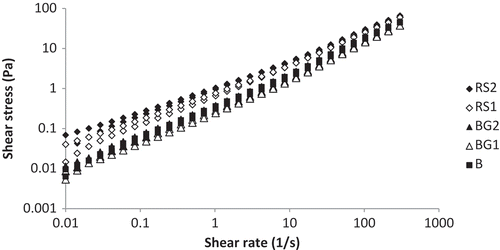
Figure 2. Apparent viscosity versus shear rate of different frozen soy yogurt mixes.
B: blank; RS1: resistant starch 1%; RS2: resistant starch 2%; BG1: beta glucan 1%; BG2%: beta glucan 2%.
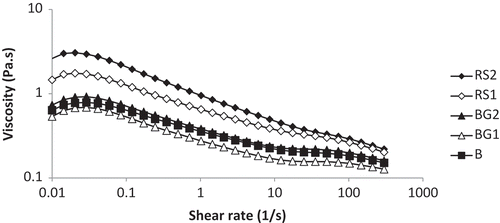
There was little difference between the flow behaviour of samples containing β-glucan and the control sample. The effect of 2% β-glucan addition on the flow behaviour was similar to resistant starch-containing samples. The shear-thinning behaviour of this sample was stronger than control, but 1% β-glucan had a different type of behaviour compared to 2% β-glucan.
The shear-thinning behaviour of frozen soy yogurt is due to irregular arrangement of molecules at low shear rates. For these shear rates, molecules are partially arranged in the same direction that leads to high viscosity. By increasing shear rates, the numbers of molecules in the similar direction increased and consequently the viscosity decreased.[Citation14] There are several reports that represent the shear-thinning behaviour of frozen yogurt mix[Citation11,Citation12,Citation15] and ice cream. Rossa et al.[Citation16] and Icier & Tavman[Citation17] stated that the non-Newtonian and shear-thinning behaviour of ice cream mix can be attributed to the aggregation of fat globules that reduce in size throughout shearing, and this event affects the ice cream viscosity.
Different behaviour of the sample containing 1% β-glucan could be attributed to possible interferences of β-glucan with the casein network that leads to a lower viscosity of this sample compared that of the control sample. Nikoofar et al.[Citation18] and Vasiljevic et al.[Citation19] also emphasized β-glucan interferences with the casein network. They stated that the presence of a long-chain polysaccharide is likely to interfere with the development of a three-dimensional structure of casein, leading to a weaker gel. For higher concentrations of β-glucan (2%), however, it is possible that its water-binding property controls this incompatibility, and so it does not show any decrease in viscosity.
To identify the flow characteristics of frozen soy yogurt mixes, the flow curves were fitted to the power law equation, which has been summarized in . The power law model was found to be adequate for describing the flow behaviour, and it gave a good fit with the data (R2 > 0.97). One parameter obtained from the application of the power law model was the flow behaviour index (n), which indicates the degree of non-Newtonian behaviour or pseudoplasticity of a fluid. Regarding , it was seen that the flow behaviour index was below 1 (ranged from 0.712 to 0.824), indicating the pseudoplastic manner of all frozen soy yogurt samples. Resistant starch and β-glucan addition decreased n and caused a reinforcement of pseudoplasticity. Resistant starch at a concentration of 2% had lower n compared to sample containing 1% resistant starch. There was no difference between two concentrations of β-glucan. The consistency coefficient (k) of mixes was increased by the addition of resistant starch, noticeably as could be expected. This increment for the sample containing 2% resistant starch was more than the 1% resistant starch-containing sample. β-glucan at a concentration of 2% increased k, but the consistency of sample containing 1% β-glucan was lower than control. Higher k values indicated a higher viscous nature because of increases in the apparent viscosity of mixes.[Citation2] However, these results demonstrated that the addition of resistant starch and 2% beta glucan gave the frozen yogurts a better resistance to the structure fracture.
Table 1. Rheological parameter obtained using power law model for different frozen soy yogurt mixes.
We investigated the tixotropic properties of samples regarding the upward and downward curves of shear stress–shear rate plots. These plots showed that the area formed between the upward and downward curves indicate that the frozen soy yogurt viscosity is time dependent. The viscosity of a tixotropic fluid decreased during time because of the rupture of the fluid structure.[Citation20] shows the hysteresis values for frozen soy yogurt samples, and it was used to compare their tixotropic properties. It could be observed that the addition of fibre caused an increase in the degree of hysteresis. This larger hysteresis loop could be attributed to the progressive breakdown of the product structure as shear time increased.[Citation21] presents that the largest and smallest hysteresis loop belonged to samples containing 2% resistant starch and 1% β-glucan, respectively. This result was expected regarding a lower viscosity for frozen soy yogurt containing 1% β-glucan. Pinto et al.[Citation15] reported that frozen yogurt containing 20% inulin had a higher viscosity and a larger hysteresis loop compared to those of the control sample.
Dynamic rheology
Frequency sweep was used to determine the viscoelastic properties. Results of this experiment were stated as storage modulus (G′), loss modulus (G″), complex modulus (G*), and loss tangent (tan δ). At frequency sweep as a typical oscillatory test, frequency was increased, while stress or strain remained constant. It was seen that all samples were frequency dependent and both G′ and G″ increased as the frequency increased ( and ). This strong dependence of G′ and G″ on frequency indicates the classic viscoelastic behaviour.[Citation4] G′ and G″ of frozen soy yogurts with a higher viscosity were hardly correlated with the frequency changes. Hence, at all tested frequencies, samples containing 2% resistant starch had the highest G′ and G″ and the lowest G′ and G″ belonged to the sample containing 1% β-glucan. Frequency dependence of G′ and G″ allows these samples to be categorized as physical gels. Linkages of the physical gel network are liable to disruption when force is applied.[Citation4] At low frequencies, G″ was greater than G,̒ confirming that frozen soy yogurts were liquid viscoelastic. Sanabria[Citation22] also reported that the frozen yogurt mix had liquid viscoelastic behaviour. At higher frequencies and after the crossover of G′ and G″ curves, this behaviour changed, and G′ was set upper than G″. The crossover point represents the transition of mixes from viscous behaviour (G’<G″) at lower frequencies to elastic behaviour (G″< G’) at higher frequencies. Adapa et al.[Citation4] studied ice cream mixes containing fat and fat replacer and reported that samples containing fat replacer G’ and G″ were frequency dependent, and both modulus increased when frequency increased.
Figure 4. Dynamic mechanical spectra of frozen soy yogurt mixes containing resistant starch.
B: blank; RS1: resistant starch 1%; RS2: resistant starch 2%.
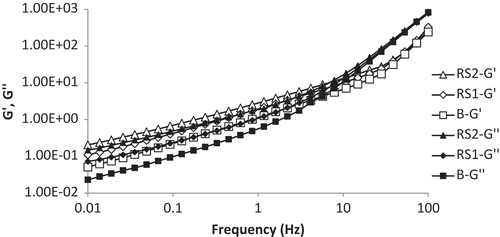
Figure 5. Dynamic mechanical spectra of frozen soy yogurt mixes containing β-glucan.
B: blank; BG1: beta glucan 1%; BG2%: beta glucan 2%.
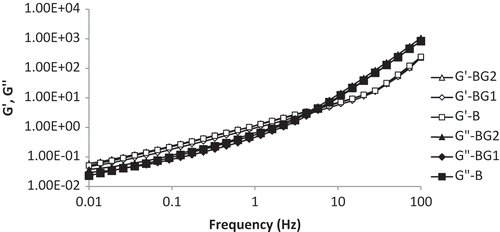
shows the effect of frequency on the G* of the frozen yogurt mix containing resistant starch and β-glucan. G* was increased when frequency increased, indicating that G*, similar to G’ and G″, is also frequency dependent. G* is an indicator of firmness. Our results showed that β-glucan had a weak effect on the firmness of samples. G* of the sample containing 1% β-glucan was lower than that in the control sample. Unlike β-glucan, resistant starch caused a considerable increment of G*, and the highest G* was seen at frozen soy yogurt containing 2% resistant starch. Dogan et al.[Citation2] achieved similar results. Their results showed the addition of xanthan gum to the ice cream mix and increased G*. The loss tangent is a popular material function for the explanation of viscoelastic behaviour; it determines whether the sample has viscous or elastic properties. Loss tangent larger than 1 means that the sample is liquid viscoelastic and lower than 1 means that the sample is solid viscoelastic. It was observed that at frequencies higher than 1 Hz, tan δ was decreased, while, at frequency higher than 10Hz, it descended to 0.3 (). This result was expected in accordance with G′ and G″ changes at frequency ranges ( and ). The highest and the lowest tan δ at the primary frequency belonged to the control sample and resistant starch, respectively. Adapa et al.[Citation4] reported that tan δ was larger than 1 for the ice cream mix containing fat replacer and they stated dry matter increment decreased tan δ, while all of samples were liquid viscoelastic.
Conclusion
The results of this study showed that addition of fibres (resistant starch and β-glucan) had a positive effect on the rheological properties of the frozen soy yogurt. Shear stress–shear rate relation was nonlinear at all samples indicating their non-Newtonian behaviour. Flow behaviour index (n) was less than 1 at all frozen soy yogurts so they were categorized as shear-thinning fluids. The power law model could explain the flow behaviour of frozen soy yogurt mixes adequately. In terms of frequency sweep test, G′ and G″ increased with frequency and regarding higher G″, they showed liquid viscoelastic behaviour. With due attention to results, resistant starch and β-glucan could be suggested as texture modifier of frozen soy yogurt.
References
- Bahramparvar, M.; Mazahri-Tehrani, M. Application and Functions of Stabilizers in Ice Cream. Food Rev. Int. 2011, 27, 389–407. DOI:10.1080/87559129.2011.563399.
- Dogan, M.; Kayacier, A.; Toker, O. S.; Yilmaz, M. T.; Karaman, S. Steady, Dynamic of Creep and Recovery AnalysisIce Cream Mixes Added with Different Concentration of Xanthan Gum. Food Bioprocess Technol. 2013, 6, 1420–1433.
- Dogan, M.; Kayacier, A. The Effect of Ageing at a Low Temperature on the Rheological Properties of Kahramanmaras-Type Ice Cream. Int. J. Food Prop. 2007, 10, 19–24.
- Adapa, S.; Dingeldein, H.; Schmidt, K. A.; Herald, T. J. Rheological Properties of Ice Cream Mixes and Frozen Ice Cream Containing Fat and Fat Replacers. J. Dairy Sci. 2000, 83, 2224–2229.
- Soukoulis, C.; Lebesi, D.; Tzia, C. Enrichment of Ice Cream with Dietary Fiber: Effects on Rheological Properties, Ice Crystallization and Glass Transition Phenomena. Food Chem. 2009, 115, 665–671.
- Bahrami, M.; Ahmadi, D.; Alizadeh, M.; Hosseini, F. Physicochemical and Sensorial Properties of Probiotic Yogurt as Affected by Addition of Different Types of Hydrocolloid. Korean J. Food Sci. Anim. Resour. 2013, 33 (3), 363–368.
- Charalampoulos, D.; Wang, R.; Pandiella, S. S.; Webb, C. Application of Cereals and Cereal Components in Functional Foods: A Review. Int. J. Food Microbiol. 2002, 79, 131–141.
- Fuentes-Zaragoza, E.; Sanchez-Zapata, E.; Sendra, E.; Sayas, E.; Navarro, C.; Fernandez-Lopez, J.; Perez-Alvarez, J. A. Resistant Starch as Prebiotic: A Review. Starch. 2011, 63, 406–415.
- Marshall, R. T.; Goff, H. D.; Hartel, R. W. Ice Cream; Kluwer Academic Publishers: New York, 2003.
- Mahdian, E.; Mazaheri-Tehrani, M.; Nobahari, M. Optimization Yogurt-Ice Cream Mix Blend in Soy Based Frozen Yogurt. J. Agric. Sci. Technol. 2012, 14, 1275–1284.
- Rezaei, R.; Khomeiri, M.; Kashaninejad, M.; Mazaheri-Tehrani, M.; Aalami, M. Effect of Resistant Starch and Aging Condition on the Physicochemical Properties of Frozen Soy Yogurt. J. Food Sci. Technol. 2015, 52 (12), 8164–8171. DOI:10.1007/s13197-015-1895-z.
- Rezaei, R.; Khomeiri, M.; Aalami, M.; Kashaninejad, M. Effect of Inulin on the Physicochemical, Flow Behavior and Probiotic Survival of Frozen Yogurt. J. Food Sci. Technol. 2014, 51 (10), 2809–2814. DOI:10.1007/s13197-012-0751-7.
- Mun, S.; Kim, Y. L.; Kang, C. G.; Park, K. H.; Shim, J. Y.; Kim, Y. R. Development of Reduced Fat Mayonnaise Using 4agtase Modified Rich Starch and Xanthan Gum. Int. J. Biol. Macromol. 2009, 44, 400–407. DOI:10.1016/j.ijbiomac.2009.02.008.
- Mahdian, E.; Mehraban- Sangatash, M.; Karazian, R.; Vaghei, T. Study the Possibility of Symbiotic Ice Cream Production Using Sugar Beet Fiber and Bifidobacterium bifidum BB-12. J. Res. Innovat. Food Sci. Technol. 2014, 3 (2), 115-128 (In Persian).
- Pinto, S. S.; Fritzen-Freire, C. B.; Munoz, I. B.; Barreto, L. M.; Prudencio, E. S.; Amboni, R. D. M. C. Effects of the Addition of Microencapsulated Bifidobacterium BB-12 on the Properties of Frozen Yogurt. J Food Eng. 2012, 111, 563–569. DOI:10.1016/j.jfoodeng.2012.03.016.
- Rossa, P. N.; Burin, V. M.; Bordignon-Luiz, M. T. Effect of Microbial Transglutaminase on Functional and Rheological Properties of Ice Cream with Different Fat Contents. LWT-Food Sci. Technol. 2012, 48, 224–230. DOI:10.1016/j.lwt.2012.03.017.
- Icier, F.; Tavman, S. Ohmic Heating Behaviour and Rheological Properties of Ice Cream Mixes. Int. J. Food Prop. 2006, 9, 679–689. DOI:10.1080/10942910600547467.
- Nikoofar, E.; Hojjatoleslamy, M.; Shakerian, A.; Molavi, H.; Shariaty, M. A. Surveying the Effect of Oat Beta Glucan as a Fat Replacer on Rheological and Physicochemical Characteristics of Non Fat Set Yoghurt. Int. J. Farming Allied Sci. 2013, 2 (20), 790–796.
- Vasiljevic, T.; Kealy, T.; Mishra, V. K. Effects of Beta-Glucan Addition to a Probiotic Containing Yogurt. J. Food Sci. 2007, 72 (7), 405–411.
- Abu Jdayil, B.; Mohameed, H. A. Time-Dependent Flow Properties of Starch-Milk-Sugar Pastes. Eur. Food Res. Technol. 2004, 218 (2), 123–127.
- Lio, H.; Xu, X. M.; Guo, S. D. Rheological, Texture and Sensory of Low Fat Mayonnaise with Different Fat Mimetics. Lwt. 2007, 40, 946–954.
- Sanabria, L. A. A.; Development of a Frozen Yogurt Fortified with a Nano- Emulsion Containing Purple Rice Bran Oil. M.Sc. thesis, Zamorano University, Honduras, 2007.

